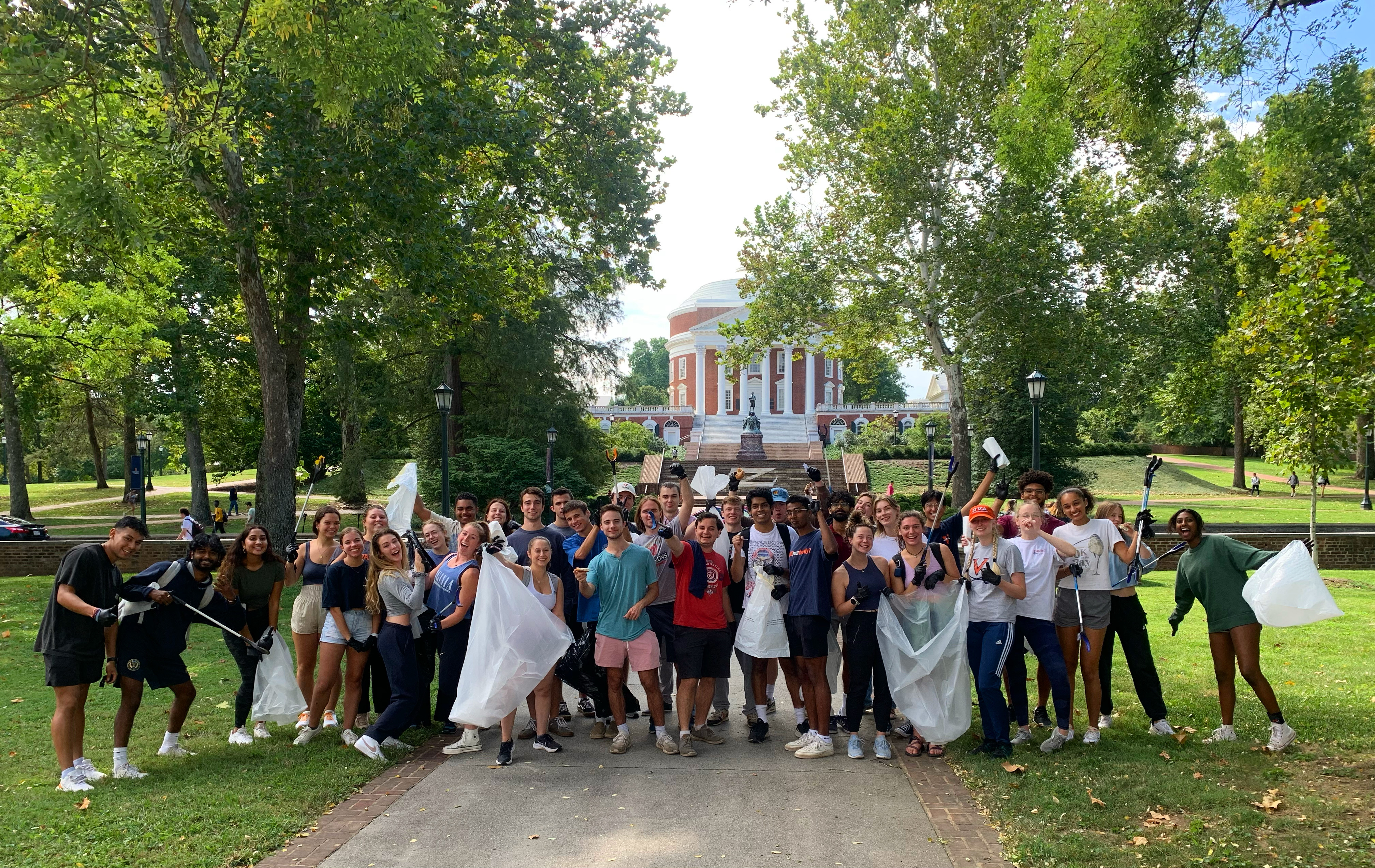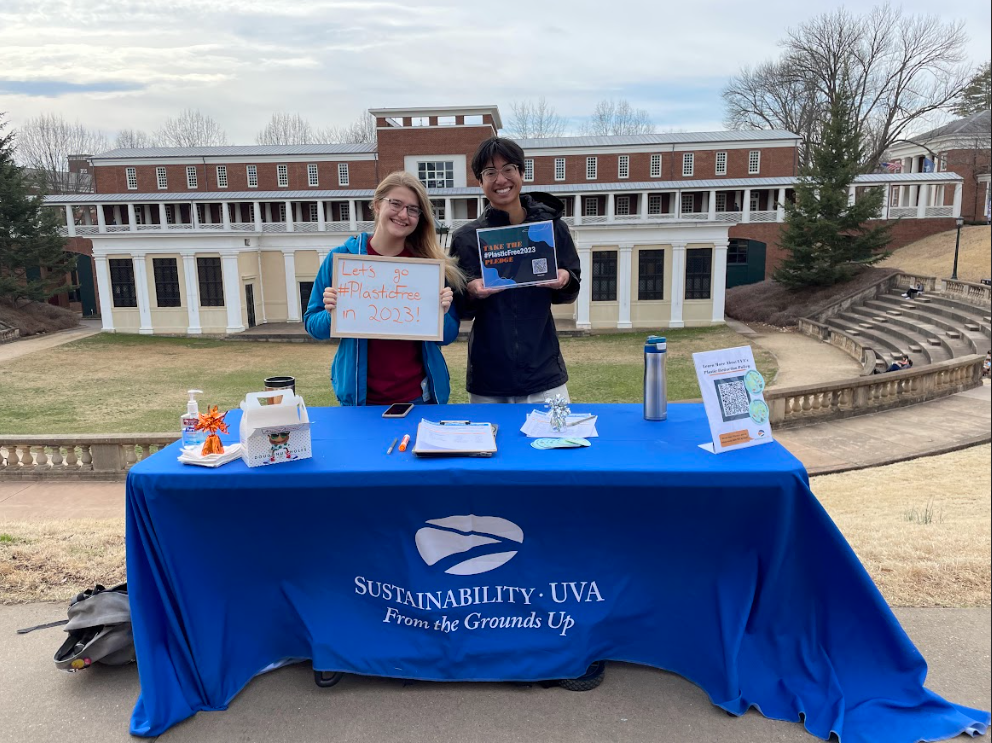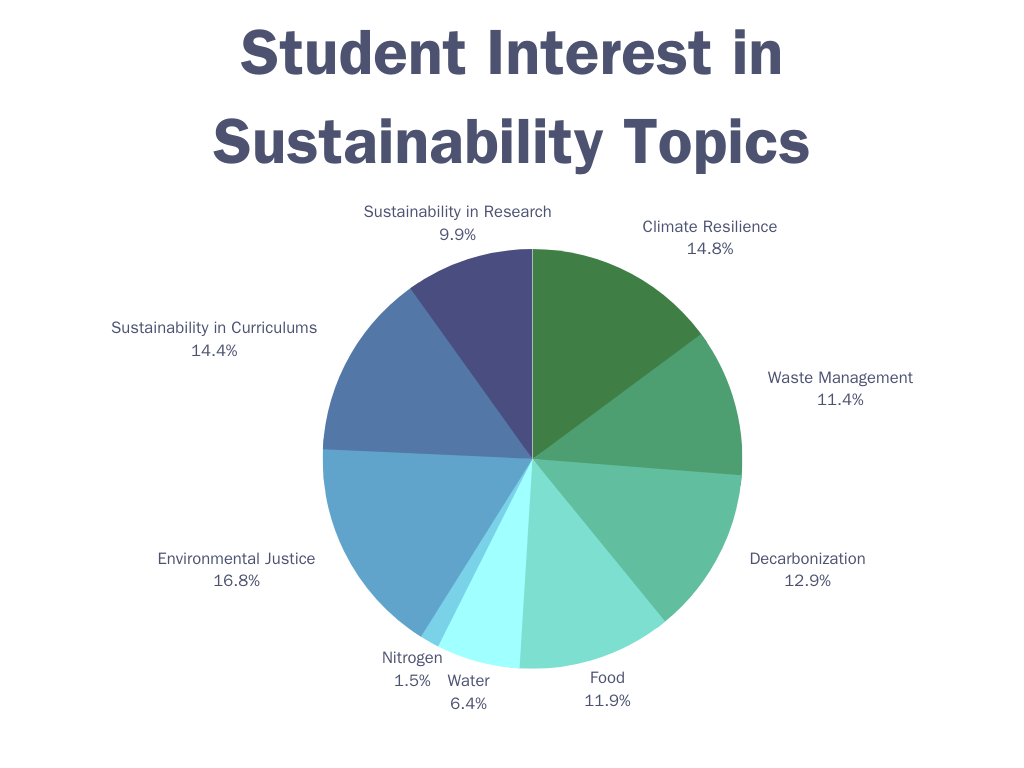Raising Awareness & Motivating Students
First, schools and offices should garner awareness among students about the plan’s development and its mission. These are the three key components:
Target audiences
Leverage existing sustainability-minded students: Students involved in environmentally-focused organizations and majors are already predisposed to engaging in long-term sustainability issues, so they are more likely to engage and invite like-minded peers. Listed below are potential student organizations and groups to contact:
- Majors: Global Studies, Environmental Thought & Practice, Environmental Science, Urban & Environmental Planning, Systems Engineering, Public Policy & Leadership
- Student organizations: Sustainability Advocates, Zero Waste Ambassadors, & CIOs
Broaden audiences: Students not already engaged in sustainability-related topics may be unaware or wary of engaging with long-term plans, but it is essential to include all perspectives. Thus, we must meet people where they are by having accessible entry points, collaborate with existing groups (coalition building), and tailor to people’s interests (stylized communications).
- Example: UVA’s Office for Sustainability collaborates with different organizations across Grounds for its Corner Cleanups, including fraternities and sororities.
Incentives & language
Career-oriented opportunities: Many students want to build their resume, so framing an engagement event as a professional development event with networking or community service opportunities might attract more students.
- Example: Sustainability Advocates is a student organization that works directly with the Office for Sustainability, offering students to build their resume, network, and implement sustainability projects at UVA.
Food & giveaways: While tabling or holding an event, food, succulents, or stickers may be a way to attract students across any discipline to engage with long-term plan awareness.
Urgency: Many students are already intrinsically motivated to engage with sustainability given the increased push for climate action, so events or tabling could give students a sense of urgency to join the cause, attracting more students.
Tools
Some of the best methods to raise awareness are ones that reach broad audiences or are visually appealing, such as chalking, tabling, social media, email classes and CIOs, or peer to peer contacts.
- Chalking and tabling are common tools UVA students and organizations employ around Grounds, particularly near the Amphitheater, South Lawn, E-Way, OHill, and Newcomb
- UVA’s Office for Sustainability primarily uses Instagram to communicate to students about upcoming events, surveys, or relevant applications.
- .Many students use GroupMe for CIO and organization communications, so sending links in commonly-used group chats is a great way to spread awareness.
- Students may be more inclined to listen to blurbs in class or over emails from professors, so reaching out to professors teaching sustainability-oriented classes may be a good way to reach a larger audience.
Two students tabling for #PlasticFree2023 campaign at UVA's Amphitheater.
Including Students in the Planning Process
Existing Methods
Already, two main groups exist to include students in long-term sustainability planning: UVA Committee on Sustainability & the Student Council Sustainability Cabinet Members. The Committee on Sustainability has three main subcommittees with even more working groups students may join. Currently, student membership in such working groups is small and limited. Similarly, the Student Council Cabinet is limited to student members elected to the position. When approaching such groups for input on sustainability plans, it is important to note their limited student membership. Therefore, with greater awareness of such existing groups, students may be more inclined to join and provide valuable input.
Potential Methods
The following methods are potential ways in which UVA can increase student participation in long-term sustainability plans:
- Surveys
- Online feedback tool
- Forums
- Focus groups
Not every method may work for the specific school, depending on students’ level of interest in involvement as well as the time commitment required. Thus, it is important to gauge such interest and time available among students to ensure the right method is utilized. As seen in the below survey, students tend to prefer surveys over other methods to provide feedback. It is important to note that students are sent surveys frequently, so sending more surveys may flood and overwhelm students.
Other Schools’ Methods
Other universities have implemented different methods of student engagement for long-term sustainability plans, such as student advisory groups and climate planning forums. These methods may be adopted by UVA if applicable.
Student Advisory Groups
The University of Pennsylvania utilizes their Student Advisory Group for the Environment (SAGE) to engage students in long-term sustainability planning, such as Penn’s Climate and Sustainability Action Plan. Students work directly with Penn’s Office for Sustainability to provide feedback on sustainability strategic planning. Although students must apply to join the group, any student is welcome to join. Further, students must attend meetings as well as maintain contact with external environmental student groups. In consideration of students’ limited time commitments, SAGE meets every couple of months, during the evening hours.
Climate Planning Forums
Indiana University’s Climate Action Planning Committee hosted a series of forums across the past few semesters for students, faculty, and staff to learn about the committee’s recommendations for the university’s climate action plan. The forums are moderated, the committee presents their recommendations, and audience members may provide comments. Forums are in-person and virtual, allowing flexibility for students. Committee members may learn from audience members certain strong opinions or protests, which could change the progress of the plan.
Equitable Engagement
It is essential that UVA schools and offices ensure equity when engaging students in long-term sustainability planning. By this, there should be equity in design, constant feedback with stakeholders, accessibility, and include a wide range of perspectives, not merely students majoring in environmental studies.
Maintaining Student Engagement
Maintaining student engagement is crucial for a participatory planning process. Considering students’ limited availability, schools and offices must be cognizant of the time commitment required for certain methods of engagement. By this, students may not be able to attend weekly meetings, but, rather, monthly meetings. Further, students want to see that their comments matter and hold value. Thus, UVA must show that it listens to feedback by illustrating its ability to change, given student feedback. This feedback and change process gives agency to students, thereby increasing their personal interest in contributing to sustainability strategic planning. Finally, maintaining constant contact with students is important for maintaining their engagement, whether that be emails, social media presence, or direct communications.
What do students want?
In March, a survey was conducted on best engagement practices with 48 respondents from current undergraduate students. Although this survey is not fully representative of the student population, as it was geared towards sustainability-minded students, these responses still provide valuable
insight to how students at UVA want to be engaged.
The top three methods of engagement students will most likely to use to contribute ideas for a sustainability plan:
- Survey
- Online feedback tool
- Forum
The top three topics students are most interested in contributing ideas towards:
- Environmental justice
- Climate resilience
- Sustainability in curriculums
Gabrielle Rosario is a fourth year student majoring in Global Sustainability and Foreign Affairs with a minor in urban & Environmental Planning. She is currently taking a Sustainability Leadership class in which students implement semester-long projects to improve sustainability at UVA, including this blog.



